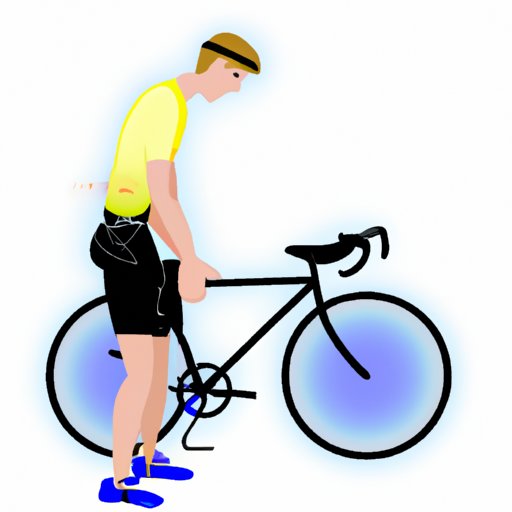Introduction
Sciatica is a condition that affects the sciatic nerve, which runs from the lower back down through the buttocks and legs. It is characterized by pain that radiates along the path of the sciatic nerve. Symptoms of sciatica include lower back pain, numbness or tingling in the legs, difficulty standing or sitting, and sharp pain when moving.
Examining the Benefits of Cycling for Sciatica Sufferers
Cycling is a low-impact exercise that can provide numerous benefits for people suffering from sciatica. The low-impact nature of cycling makes it an ideal activity for those whose sciatica symptoms limit their ability to engage in more strenuous physical activities. Cycling can also help improve mobility, reduce pain, and strengthen muscles, all of which can help alleviate sciatica symptoms.

Exploring How Cycling Can Help Alleviate Sciatica Pain
One of the main benefits of cycling for sciatica sufferers is that it helps increase blood flow to the affected area. This increased blood flow helps to bring oxygen and nutrients to the region, which can help reduce inflammation and pain. Additionally, cycling strengthens the muscles in the lower back, hips, and thighs, which can help support the spine and reduce pressure on the sciatic nerve. Finally, cycling can help improve posture, which can in turn reduce the strain on the sciatic nerve.

The Pros and Cons of Cycling for Sciatica Relief
Although cycling can provide many benefits for sciatica sufferers, it is important to be aware of the potential risks and side effects. Some of the pros of cycling for sciatica relief include:
- Low-impact exercise
- Improved mobility
- Reduced pain
However, there are some potential cons to consider as well. These include:
- Risk of injury
- Difficulty with balance
- Time commitment
How to Use Cycling as a Treatment for Sciatica
If you decide to use cycling as a treatment for your sciatica, it is important to take the proper steps to ensure your safety and maximize the potential benefits. First, it is important to select the right bike. Mountain bikes and hybrid bikes are usually better suited for off-road cycling, while road bikes are better suited for on-road cycling. It is also important to adjust the bike for maximum comfort. Make sure the seat is at the correct height and the handlebars are at the correct angle. Finally, it is important to create an appropriate cycling routine. Start with shorter rides and gradually increase the length and intensity of the rides as your strength and endurance improve.
The Scientific Evidence Supporting Cycling for Sciatica
There have been numerous studies examining the efficacy of cycling for sciatica relief. Most of these studies have found that cycling has positive effects on sciatica symptoms. In one study, participants who cycled three times a week for six weeks reported a significant decrease in pain and an improvement in quality of life. Another study found that cycling was effective in reducing sciatica-related disability. However, it is important to note that there can be potential side effects such as fatigue, muscle soreness, or even nerve damage if cycling is done improperly.

Understanding the Mechanisms Behind Cycling and Sciatica Relief
The mechanisms behind how cycling can help reduce sciatica pain are not completely understood. However, experts believe that the increased blood flow and improved posture associated with cycling can help reduce inflammation and relieve pressure on the sciatic nerve. Additionally, cycling can help release endorphins, which can help reduce pain. Finally, cycling can help strengthen the muscles in the lower back, hips, and thighs, which can help support the spine and reduce pressure on the sciatic nerve.
Conclusion
Cycling can be a great form of low-impact exercise for those with sciatica. It can help alleviate symptoms by improving mobility, reducing pain, increasing blood flow, and strengthening muscles. However, there are potential risks and side effects to consider before beginning a cycling routine. It is important to select the right bike, adjust it for maximum comfort, and create an appropriate cycling routine. Additionally, it is important to be aware of the potential side effects of cycling. With the proper precautions, cycling can be an effective way to reduce sciatica pain and improve quality of life.


